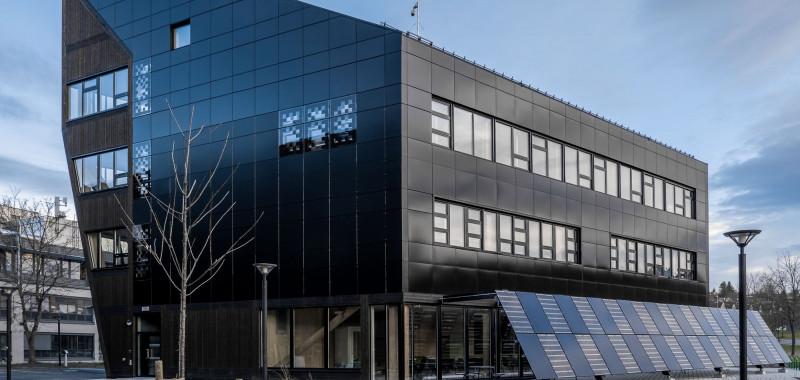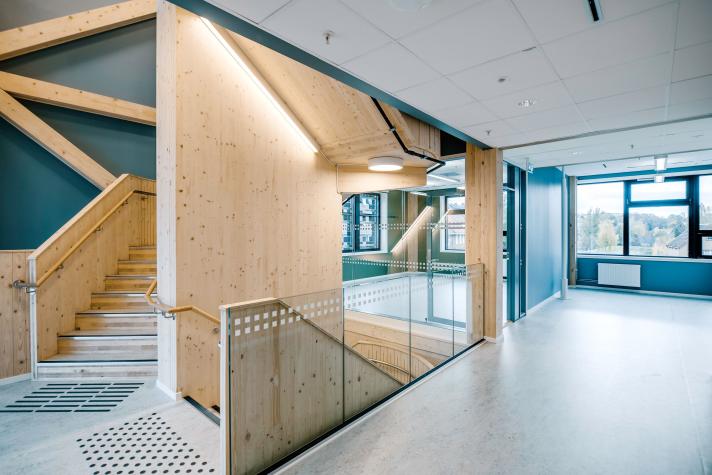
There are various ways to store excess carbon dioxide. ‘One way is to have it hidden in buildings,’ says Tero Hasu, a project manager at Kouvola Innovation, a municipally owned development company of the City of Kouvola in Finland. The ZEB (zero emission building) Lab achieves this by using wood for almost everything – from beams to pillars and staircases. Concrete is to be found only in the foundations and the ground floor.
But while exciting wooden structures are springing up across the world – including fancy wooden skyscrapers from Norway to Milwaukee in the US – they remain the exception in most countries. Researchers now believe there’s an urgent need to shift gear and make construction from wood mainstream.
‘Every building that goes over four storeys, or even lower, is a research or demonstration project,’ observed Dr Niels Morsing, director of wood and biomaterials at the Danish Technological Institute in Copenhagen. ‘There’s a lot of effort going into proving performance. It’s one of the barriers that we don’t have “pre-accepted” solutions.’
Climate solution
Advocates say building in wood, if it went mainstream, could house a growing population and provide a dramatic climate solution. Over the next four decades, nearly 230 billion square metres of new construction will be needed to support the world’s increasingly dense cities, according to the United Nations Environment Programme’s 2017 Global Status Report.
As trees grow, they sequester carbon – about one tonne of CO2 for every cubic metre of wood. While carbon is emitted in processing the wood, the production of concrete is notoriously carbon-intensive. Just the chemical reaction that produces a tonne of cement releases about half a tonne of CO2. Provided the trees come from sustainable forests - so they are replaced when chopped down - and as long as the wood is recycled at the end of a building’s life, it could be a powerful solution.
Yet it is thought that well under 10% of construction in Europe is of wood. Researchers in Finland recently calculated that, if the percentage of wooden buildings in Europe increased steadily from 10% in 2020 to 80% in 2040, and if these buildings contained more wooden components than before (such as beams, floors, ceilings and cladding) then a total of 0.42 gigatonnes of carbon could be stored over the 20-year period.
Wooden components such as beams, floors, ceilings and cladding in buildings can help increase the amount of carbon stored in the structure. Image credit - Kouvola Innovation Oy/NERO project
Reluctance
But there is a reluctance to use wood, says Dr Morsing, sometimes for understandable, if outdated, reasons.
One reason is a fear of fire, partly because of ancestral memories of medieval towns in flames.
‘Of course, wood burns and you have to make your design and your strategy of fire protection accordingly,’ he said. But regulations focus on whether a building can be evacuated quickly – and that depends on many factors, not just the construction material. Deploying sprinklers, covering wooden facades with plaster, or using concrete in critical areas such as staircases can be strategies.
Fires are also less of a problem when using mass timber. This is high-tech, engineered wood, such as cross-laminated timber (CLT), created by stacking multiple layers of timber at 90 degrees to each other under pressure.
Mass timber – like a thick tree – burns just on the outside, the charcoal shielding the wood from further combustion within. With the right techniques ‘it’s possible to make a wooden building as safe as a brick or concrete building,’ said Dr Morsing.
Rotting is another problem that has yielded to new treatments and coverings, and can be minimised with the selection of the right tree species, he adds.
Then there’s strength: how safe would you feel on the 80th floor of the proposed Oakwood Timber Tower in the centre of London? In fact, mass wood can be stronger than concrete, and steel and concrete can be used, sparingly, in taller structures to add rigidity, say experts.
Industrialised
But there are other, less tractable obstacles. Since the 1960s, construction has industrialised, becoming a cheap, reproducible and fast system in which builders know what they are getting, engineers know what they are calculating and architects understand what is possible.
‘It’s a matter of industrialising the wooden industry in order to compete on cost,’ said Dr Morsing.
For example, although there are several firms manufacturing CLT, there are no common standards for its production. ‘It’s not so easy to use,’ said Dr Morsing, ‘because if you are an engineer or an architect you have several products available and you have to calculate in accordance with the specific supplier.’
‘It’s a matter of industrialising the wooden industry in order to compete on cost.’
Dr Niels Moring, Danish Technological Institute
Hasu agrees. He says that the main challenge is that structural components such as walls, partitions and floors (known as planar elements) are not standardised. ‘Developers are not interested in developing a wooden solution on their own; they want to buy ready solutions. But wood is not standardised.’ All the distinctive wooden buildings in Scandinavia, for example, are more or less tailor-made, he says.
Another frustration is that most building codes and regulations date back to before timber was a high-tech product.
Dr Morsing oversees a project called Build-in-Wood, which aims to drastically increase the proportion of wood used in the construction of multi-storey buildings by documenting and systematising wood components so that the construction industry finds it easy to use them.
That means every unit of the same item needs to perform well, measurably and consistently. It also means figuring out how to pre-fabricate the components so they can be mass-produced off-site. Build-in-Wood is also helping six European cities to build more in timber.
As well as constructing the ZEB Lab building, Hasu’s project, NERO, has focused on improving the design and manufacturing processes of nearly zero energy buildings in general, such as how to make them sufficiently energy-efficient to withstand bitter northern winters, and do well despite seasonal fluctuations in temperature, light and moisture.
‘I love the (ZEB building),’ said Hasu, ‘because they have tried to do it all.’ He says it’s a good example of how much can be done with pre-planning and the materials we have today.
The building was built for a university and energy research company SINTEF, so he says they were instinctively open-minded when it came to trying new approaches to construction.
But Hasu, who has spent 30 years working on industrialised construction and sites, believes once people experience living or working inside a mainly wooden building rather than a concrete one, they will be converted. ‘It’s much more quiet … and the wooden surface evens out the moisture inside – it is breathing. There’s not so much echo inside. It’s a very different feeling.’
The research in this article was funded by the EU.If you liked this article, please consider sharing it on social media.
This post They can capture more carbon than they emit. So why aren’t wooden buildings mainstream? was originally published on Horizon: the EU Research & Innovation magazine | European Commission.
Details
- Publication date
- 3 May 2023

